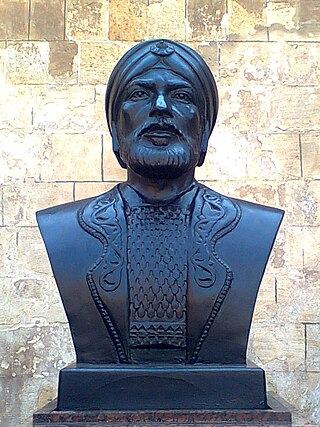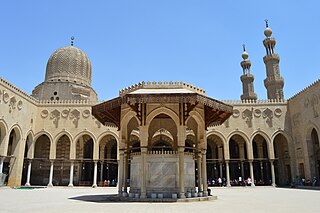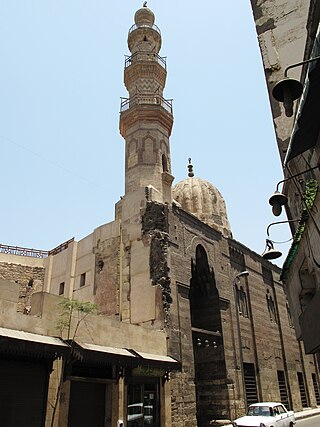
Al-Maqrīzī was a medieval Egyptian historian and biographer during the Mamluk era, known for his interest in the Fatimid era, and the earlier periods of Egyptian history. He is recognized as the most influential historian of premodern Egypt.

Sayf al-Din Qutuz, also romanized as Kutuz or Kotuz and fully al-Malik al-Muẓaffar Sayf ad-Dīn Quṭuz, was the Mamluk Sultan of Egypt. He reigned as Sultan for less than a year, from 1259 until his assassination in 1260, but served as the de facto ruler for two decades.

Al-Malik an-Nasir Nasir ad-Din Muhammad ibn Qalawun, commonly known as an-Nasir Muhammad, or by his kunya: Abu al-Ma'ali or as Ibn Qalawun (1285–1341) was the ninth Mamluk sultan of the Bahri dynasty who ruled Egypt between 1293–1294, 1299–1309, and 1310 until his death in 1341. During his first reign he was dominated by Kitbugha and al-Shuja‘i, while during his second reign he was dominated by Baibars and Salar. Not wanting to be dominated or deprived of his full rights as a sultan by his third reign, an-Nasir executed Baibars and accepted the resignation of Salar as vice Sultan.

The Mosque-Madrasa of Sultan Hasan is a monumental mosque and madrasa located in Salah al-Din Square in the historic district of Cairo, Egypt. It was built between 1356 and 1363 during the Bahri Mamluk period, commissioned by Sultan an-Nasir Hasan. The mosque was considered remarkable for its massive size and innovative architectural components, and is still considered one of the most impressive historic monuments in Cairo today.

Izz al-Din Aybak was the first of the Mamluk sultans of Egypt in the Turkic Bahri line. He ruled from 1250 until his death in 1257.

Shajar al-Durr, also Shajarat al-Durr, whose royal name was al-Malika ʿAṣmat ad-Dīn ʾUmm-Khalīl Shajar ad-Durr, was a ruler of Egypt. She was the wife of As-Salih Ayyub, and later of Izz al-Din Aybak, the first sultan of the Mamluk Bahri dynasty. Prior to becoming Ayyub's wife, she was a child slave and Ayyub's concubine.

Kitbugha, royal name: al-Malik al-Adil Zayn-ad-Din Kitbugha Ben Abd-Allah al-Mansuri al-Turki al-Mughli; Arabic: الملك العادل زين الدين كتبغا بن عبد الله المنصورى التركى المغلى) was the 10th Mamluk sultan of Egypt from December 1294 to November 1296.

The Qalawun complex is a massive pious complex in Cairo, Egypt, built by Sultan al-Mansur Qalawun from 1284 to 1285. It is located at Bayn al-Qasrayn on al-Mu'izz street and like many other pious complexes includes a hospital (bimaristan), a madrasa and mausoleum. Despite controversy surrounding its construction, this building is widely regarded as one of the major monuments of Islamic Cairo and of Mamluk architecture, notable for the size and scope of its contributions to legal scholarship and charitable operations as well as for the richness of its architecture.

The Mosque of Sultan al-Mu'ayyad is a Mosque in Cairo, Egypt next to Bab Zuwayla built under the rule of sultan Al-Mu'ayyad Sayf ad-Din Shaykh from whom it takes its name, "Al-Mu'ayyad", meaning The Supporter in Arabic language. Construction began in 1415 and the mosque was completed in 1421. The complex included a Friday mosque and a madrasa for four madhhabs. It replaced a prison which originally stood next to Bab Zuwayla.

The cruciform Madrasah of the Amir Sarghatmish, built in 1356, lies to the northeast of the Mosque of Ibn Tulun, in Islamic Cairo. The building's school, mosque, and mausoleum can be seen from Ibn Tulun's spiral minaret, while its entrance is on Saliba Street. This structure includes a madrasa, mosque, and mausoleum. The madrasa is also referred to as the Mosque of Amir al-Sayf Sarghatmish.

The Salihiyya Madrasa, also called the Madrasa and Mausoleum of as-Salih Najm ad-Din Ayyub is a historic madrasa and mausoleum complex in Cairo, Egypt. The complex was founded by the Ayyub sultan As-Salih Ayyub in 1242 and his mausoleum was added to it by Shajarr ad-Durr upon his death in 1249. It was one of the most prominent centers of Islamic learning in the Ayyubid and Mamluk era in the 13th–14th centuries CE. Its remains are located on al-Muizz Street in the historic district of Cairo across from the Complex of Sultan Qalawun.
Taqi al-Din Muhammad ibn Ahmad al-Fasi was an Arab Muslim scholar, muhaddith, faqih (jurist), historian, genealogist and a Maliki qadi (judge) in Mecca.

The Mosque and Khanqah of Shaykhu is an Islamic complex in Cairo built by the Grand Emir Sayf al-Din Shaykhu al-Nasiri. The mosque was built in 1349, while the khanqah was built in 1355. Shaykhu was the Grand Emir under the rule of Sultan an-Nasir Hasan.

The Madrasa of al-Nasir Muhammad is a madrasa and mausoleum located in the Bayn al-Qasrayn area of al-Muizz street in Cairo, Egypt. It was built in the name of the Mamluk sultan al-Nasir Muhammad ibn Qalawun, but its construction began between 1294 and 1295 under the reign of Sultan al-Adil Kitbugha, who was sultan in between al-Nasir Muhammad's first and seconds reigns. When al-Nasir Muhammad returned to the throne in 1299 he oversaw its construction until its completion in 1303. It is adjacent to the earlier hospital and funerary complex of Sultan Qalawun and the later Madrasa of Sultan Barquq.
Sanjar ibn Abdullah Alam al-Din Abu Sa'id al-Jawli was a powerful Mamluk emir and the Governor of Gaza and much of Palestine between 1311–20 during the sultanate of an-Nasir Muhammad and then again for a brief time in 1342 during the reign of the latter's son as-Salih Ismail. Prior to his first term as governor, al-Jawli briefly served as the Emir of Shawbak in Transjordan and before his second term as Gaza's governor, he was appointed Governor of Hama for three months.
Al-Nasir Badr ad-Din Hasan ibn Muhammad ibn Qalawun, better known as al-Nasir Hasan, was the Mamluk sultan of Egypt, and the seventh son of al-Nasir Muhammad to hold office, reigning twice in 1347–1351 and 1354–1361. During his first reign, which he began at age 12, senior Mamluk emirs formerly belonging to al-Nasir Muhammad, dominated his administration, while al-Nasir Hasan played a ceremonial role. He was toppled in 1351 when he attempted to assert executive authority to the chagrin of the senior emirs. He was reinstated three years later during a coup against his brother Sultan al-Salih Salih by emirs Shaykhu and Sirghitmish.

The Madrasa of Umm al-Sultan Sha'ban is a Mamluk-era complex located in the Al-Darb al-Ahmar area of Islamic Cairo in Egypt. It was founded or built in 1368-69 CE on the order of Sultan al-Ashraf Sha'ban in honour of his mother, Khawand Baraka. It is located outside Bab Zuweila along al-Tabbana street, and is adjoined to the north by the Bayt al-Razzaz palace. The complex is made up of a college (madrasa), mausoleum, water trough (hawd), and a primary school (maktab).

The Mosque and Mausoleum of Amir Ahmad al-Mihmandar which is also referred to as the al-Mihmandariyya college (madrasa) was founded during the third reign of al-Nasir Muhammad in the area of Darb al-Ahmar in Cairo.

The Madrasa of Uljay al-Yusufi was built in the area between Bab Zuwayla and the Cairo Citadel during the reign of the Mamluk sultan Al-Ashraf Sha'ban.
The Mosque of Almalik al-Jukandar is located near the Mashad of Husayn and Al-Azhar Mosque in the historic area of Cairo. Founded during the Bahri Mamluk period during the third reign of Al-Nasir Muhammad, it is less documented by modern researchers and historians.
















